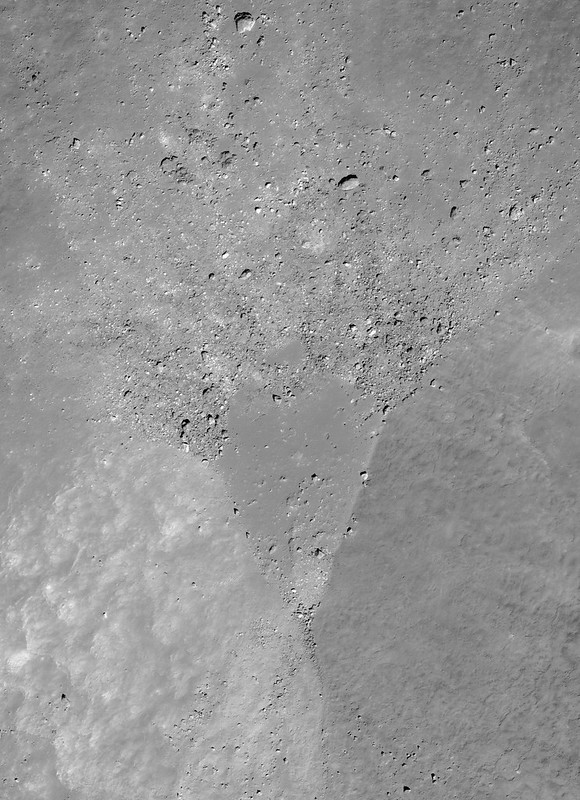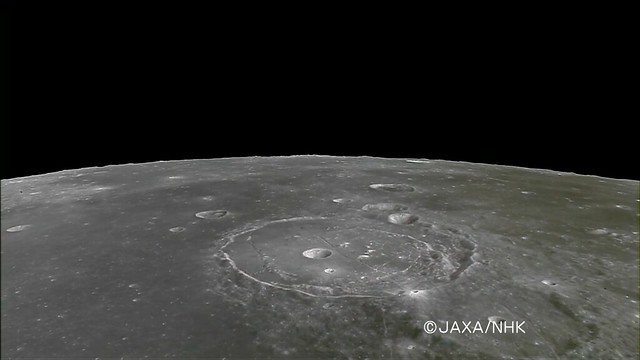 |
| Deep interior of an unnamed Copernican crater (30.363°N, 30.705°E) notched on the south rim of Posidonius, the 95 km pre-Imbrium crater on the northeast edge of Mare Serenitatis. The slope of the impact zone and angle of attack resulted in a triangular melt pond at the exposed center. Photograph from a mosaic of mosaics stitched from four overlapping LROC Narrow Angle Camera (NAC) frames taken 177 days apart (M157391825RL and M172717111LR), field of view 1160 meters, resolution 48 cm [NASA/GSFC/Arizona State University]. |
Lunar Pioneer
Posidonius (95 km, 31.878°N, 29.991°E) is a well-known floor-fractured crater, and a grand sight even through small telescopes in early evenings before First Quarter or before dawn, four days after a Full Moon. It is also an enduring crater, a remnant of the Moon's surface before the basin-forming impacts creating Mare Serenitatis, Mare Crisium and Mare Imbrium.
With regard to the oldest of these three basin, Serenitatis, Posidonius clings to its inundated northeastern edge, carrying scars from each of these epoch-changing events as well as the continuous gardening of subsequent lunar bombardments, both large, small and microcosmic.
A kind of ready-made construction site for an observation post is notched into the north-facing.southern wall of Posidonius, very near the rim, and it features more than just an excellent view of the southern interior of the ancient crater. In terms of superposition and strategraphy this "improvement," in the form of a relatively recent small Copernican age crater may also be an observation post into the Moon's deeper past and the history of our star system.
"30-30" crater, informally named for its location near 30°N, 30°E (30.363°N, 30.705°E), is a bright and distinctive two kilometer notch excavated on Posidonius' wall, near the top of its
south-southeastern wall, a result of a relatively recent impact in the past half-billion
years or so, a youngster in the neighborhood and on the lunar timescale.
The oldest, or at least deepest, material a lunar impact tosses out ends up on the crater's rim. So this small younger impact did future geologists a service. Efficiently, "nature's dynamite" excavated material originally thrown up and out from the Posidonius impact event and, as luck would have it, ejecta from Chancornac, also a pre-Imbrium crater to the southeast and more or less sharing the same rim.
The entire region is characterized by intriguing hints of underlying features in addition to its more obvious scars from disrupting shocks. Posidonius and its vicinity are deeply faulted, its floor scoured,
inundated and subsequently drained of catastrophic lava flows and was clearly, on more than one occasion, subject to energies powerful enough to buckle its underlying floor.
A distinctive sinuous rille circumscribes the interior wall of Posidonius pointing to a rapid disbursal of.heated flows into Serenitatis at some point in its busy past.
Old Posidonius is at a crossroads in space, between crater-saturated highlands and the deeper plains of Lacus Somniorum and Mare Serenitatis, and it also sits at a crossroads in time, being older than Serenitatis and carrying some of the same history as the Sculptured Hills near the landing site of Apollo 17, 300 km to the south.
To get below these scars to sample the material originally tossed up by Posidonius in the dim past, before Serenitatis we would need to dig its its rim. Fortunately, the progenitor of "30-30" already did the digging.
Posidonius (95 km, 31.878°N, 29.991°E) is a well-known floor-fractured crater, and a grand sight even through small telescopes in early evenings before First Quarter or before dawn, four days after a Full Moon. It is also an enduring crater, a remnant of the Moon's surface before the basin-forming impacts creating Mare Serenitatis, Mare Crisium and Mare Imbrium.
With regard to the oldest of these three basin, Serenitatis, Posidonius clings to its inundated northeastern edge, carrying scars from each of these epoch-changing events as well as the continuous gardening of subsequent lunar bombardments, both large, small and microcosmic.
A kind of ready-made construction site for an observation post is notched into the north-facing.southern wall of Posidonius, very near the rim, and it features more than just an excellent view of the southern interior of the ancient crater. In terms of superposition and strategraphy this "improvement," in the form of a relatively recent small Copernican age crater may also be an observation post into the Moon's deeper past and the history of our star system.
 |
| A full-resolution sample of the mosaic of mosaics shows a a straight contact between the wall and floor of "30-30" crater. The left (west) side of the 272 meter field of view shows part a flat triangular melt zone, with an upslope on eastern wall. If the crater's progenitor impacted in a relatively flat plain, presumably the contact would have been the border of an encircled melt pond. LROC NAC M172717111LR, LRO orbit 10587, October 8, 2011; 34.21° angle of incidence, resolution 47 cm from 39 kilometers [NASA/GSFC/Arizona State University]. |
The oldest, or at least deepest, material a lunar impact tosses out ends up on the crater's rim. So this small younger impact did future geologists a service. Efficiently, "nature's dynamite" excavated material originally thrown up and out from the Posidonius impact event and, as luck would have it, ejecta from Chancornac, also a pre-Imbrium crater to the southeast and more or less sharing the same rim.
 |
| The interior and east side of "30-30," shows small intriguing exposures of "dark halo" material on the crater's east wall and deposited with it's southeastward ejecta. LROC NAC M172717111LR [NASA/GSFC/Arizona State University]. |
A distinctive sinuous rille circumscribes the interior wall of Posidonius pointing to a rapid disbursal of.heated flows into Serenitatis at some point in its busy past.
Old Posidonius is at a crossroads in space, between crater-saturated highlands and the deeper plains of Lacus Somniorum and Mare Serenitatis, and it also sits at a crossroads in time, being older than Serenitatis and carrying some of the same history as the Sculptured Hills near the landing site of Apollo 17, 300 km to the south.
To get below these scars to sample the material originally tossed up by Posidonius in the dim past, before Serenitatis we would need to dig its its rim. Fortunately, the progenitor of "30-30" already did the digging.
 |
| A thumbnail, very much a miniature 580 pixel-wide reduction of the 9600 sample-wide "mosaic of mosaics" high-resolution and finely detailed survey of the "30-30" excavation of the ancient rim of Posidonius. LROC NAC mosaic of M172717111LR and the overlapping NAC observation swept up 177 days earlier, M157391825LR, from LRO orbit 8329, April 14, 2011; 35.35° angle of incidence, 48 cm per pixel resolution from 41.18 km [NASA/GSFC/Arizona State University]. |
As "the
Rosetta Stone of the Solar System," the Moon is a history of
bombardment (in the inner Solar System and, more importantly for us, in the
vicinity of Earth) at a frequency and magnitude supposed to have steadily fallen off
from its beginning roughly 4.575 billion years ago. A question as
enduring as Posidonius, perhaps, is whether the rate of this bombardment might once have
increased for a time, perhaps as a consequence of a disrupting shuffle in
the orbits of the outer planets somewhat "late" in our star system's history, within its first billion years.
From the Real Estate trade we borrow the all-encompassing Latin word Situs, familiarly translated (outside strict legal circles) as "location is everything," or "location, location, location." Though "30-30" may not perhaps be uniquely situated, it may, if little else at this point, illustrate one way to determine the relative value of places on the Moon as they might be chosen for their value to science.
 |
| The dramatic disruption inside Posidonius, even the bright "30-30" crater itself, can distract the eye away from deep fractures nearby. Note a long fault line running south away from the rim of Posidonius, easily mistaken for a photographic artifact. A 34 km-wide field of view from LROC Wide Angle Camera (WAC) monochrome (566 nm) observation M159752877C, LRO orbit 8677, May 11, 2011; 53.58° incidence angle, resolution 58.8 meters from 42.28 km [NASA/GSFC/Arizona State University]. |
"30-30" itself presents to us a fairly average Copernican crater, for its size, though its location (there's that word again) perhaps more than its progenitor's angle of attack, caused it to end up presenting an atypical interior.
Instead of a round interior melt pond, or disk of impact melt at the center, the melt at the exposed center of "30-30" ended up triangular, making it into a flat balcony on Posidonius' south wall. It's essentially missing north has left the triangular melt pond to the mercy of steady erosion, shedding boulders and other fine, bright material down onto the slumped terraces of Posidonius' walls.
It's bright ejecta is marked in a few places by a definitely darker material, what might be an exposed layer or vein of dark halo material or even cryptomare half-way down the small crater's southeast wall. Additionally, there are at least two patches of perhaps this same darker material to the small crater's southeast and southwest, on its "normal" ejecta.
All in all, what else has the "30-30" crater "dug up?"
Instead of a round interior melt pond, or disk of impact melt at the center, the melt at the exposed center of "30-30" ended up triangular, making it into a flat balcony on Posidonius' south wall. It's essentially missing north has left the triangular melt pond to the mercy of steady erosion, shedding boulders and other fine, bright material down onto the slumped terraces of Posidonius' walls.
It's bright ejecta is marked in a few places by a definitely darker material, what might be an exposed layer or vein of dark halo material or even cryptomare half-way down the small crater's southeast wall. Additionally, there are at least two patches of perhaps this same darker material to the small crater's southeast and southwest, on its "normal" ejecta.
All in all, what else has the "30-30" crater "dug up?"
Related Posts:
Meanders in Posidonius (February 13, 2013)
Geological mapping of another world (January 25, 2013)
Rimae Posidonius (December 1, 2010)






No comments:
Post a Comment